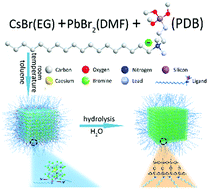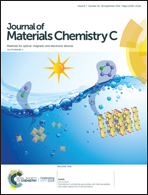Branched capping ligands improve the stability of cesium lead halide (CsPbBr3) perovskite quantum dots†
Abstract
Design principles using branched capping ligands, namely, n-propyltrimethoxysilane-dimethyloctadecylammonium bromine (PDB), were developed to improve the stability of CsPbBr3 perovskite quantum dots (QDs) for light-emitting applications. As the PDB ligands polymerized on the surface of CsPbBr3 QDs, this avoided the highly dynamic ligand binding-desorption process, Ostwald ripening, and phase transition of CsPbBr3 QDs that occur with traditional oleic acid (OA)/oleylamine (OLA) ligands. Therefore, CsPbBr3 QDs with PDB ligands exhibited much better stability for air, ethanol, high temperature and UV irradiation than OA/OLA–CsPbBr3 QDs. As the light-induced ligand peeling and nanocrystal fusion were inhibited, the phosphor-converted LED with PDB–CsPbBr3 QDs could retain 82% of the initial photoluminescence (PL) intensity after 436 h of illumination, which represented a 27-fold improvement over the LED with OA/OLA–CsPbBr3 QDs. This is the best reported device stability of a phosphor-converted LED based on CsPbBr3 QDs to date.



 Please wait while we load your content...
Please wait while we load your content...